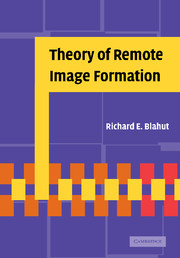Book contents
- Frontmatter
- Contents
- Preface
- Acknowledgements
- 1 Introduction
- 2 Signals in one dimension
- 3 Signals in two dimensions
- 4 Optical imaging systems
- 5 Antenna systems
- 6 The ambiguity function
- 7 Radar imaging systems
- 8 Diffraction imaging systems
- 9 Construction and reconstruction of images
- 10 Tomography
- 11 Likelihood and information methods
- 12 Radar search systems
- 13 Passive and baseband surveillance systems
- 14 Data combination and tracking
- 15 Phase noise and phase distortion
- References
- Index
8 - Diffraction imaging systems
Published online by Cambridge University Press: 19 August 2009
- Frontmatter
- Contents
- Preface
- Acknowledgements
- 1 Introduction
- 2 Signals in one dimension
- 3 Signals in two dimensions
- 4 Optical imaging systems
- 5 Antenna systems
- 6 The ambiguity function
- 7 Radar imaging systems
- 8 Diffraction imaging systems
- 9 Construction and reconstruction of images
- 10 Tomography
- 11 Likelihood and information methods
- 12 Radar search systems
- 13 Passive and baseband surveillance systems
- 14 Data combination and tracking
- 15 Phase noise and phase distortion
- References
- Index
Summary
Because of their very small wavelengths (usually less than a nanometer), X-rays can be used to obtain valuable information about the structure of very small objects. The diffraction of X-rays by a crystal can provide information about the lattice structure of the crystal, the shape of the molecules making up the crystal, and the irregularities in the lattice structure.
The molecules of a crystal are arranged in a regular lattice with a spacing between them that is comparable to the wavelength of X-rays. An incident X-ray propagates as an electromagnetic wave and is diffracted by the crystal. The diffracted wave forms sharp grating lobes in the far-field diffraction region because of the periodic structure of the crystal. The distribution of these grating lobes in solid angle depends on the lattice structure of the crystal, while the relative amplitudes of the grating lobes depend on the electron structure of the molecules making up the crystal. The width of the grating lobes depends on the irregularities in the crystal structure.
We shall begin this chapter with a discussion of the three-dimensional Fourier transform. Then the diffraction of a plane wave by a three-dimensional crystal will be described by using the three-dimensional Fourier transform.
The three-dimensional Fourier transform
A function, s(x, y, z), possibly complex, of three variables, is called a three-dimensional function, or a three-dimensional signal. In many applications, s(x, y, z) will be a real-valued function; indeed, s(x, y, z) often will be a nonnegative, real-valued function that can be visualized as the density of a diffuse cloud. The density of the cloud at point x, y, z is s(x, y, z).
- Type
- Chapter
- Information
- Theory of Remote Image Formation , pp. 254 - 286Publisher: Cambridge University PressPrint publication year: 2004



